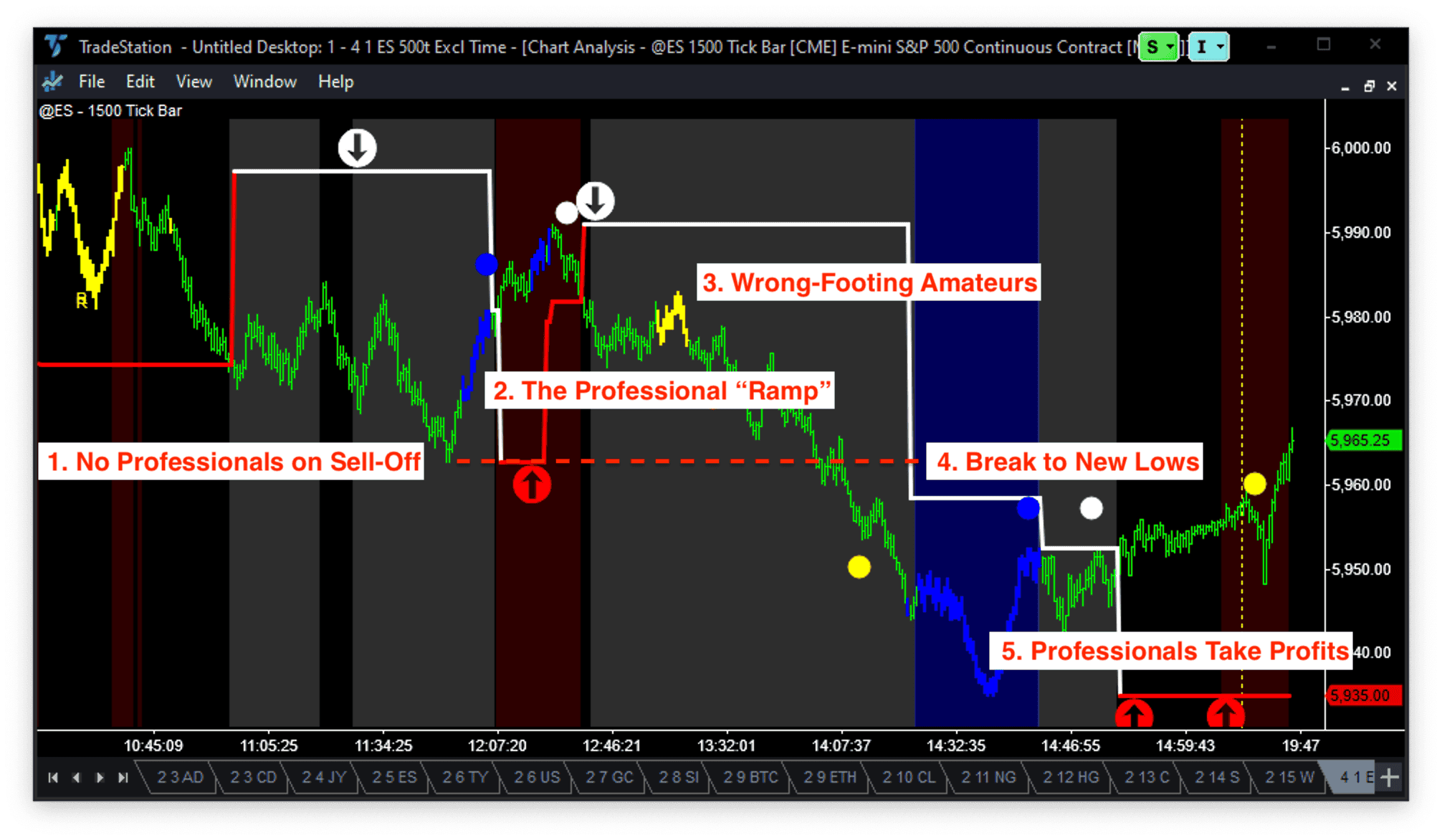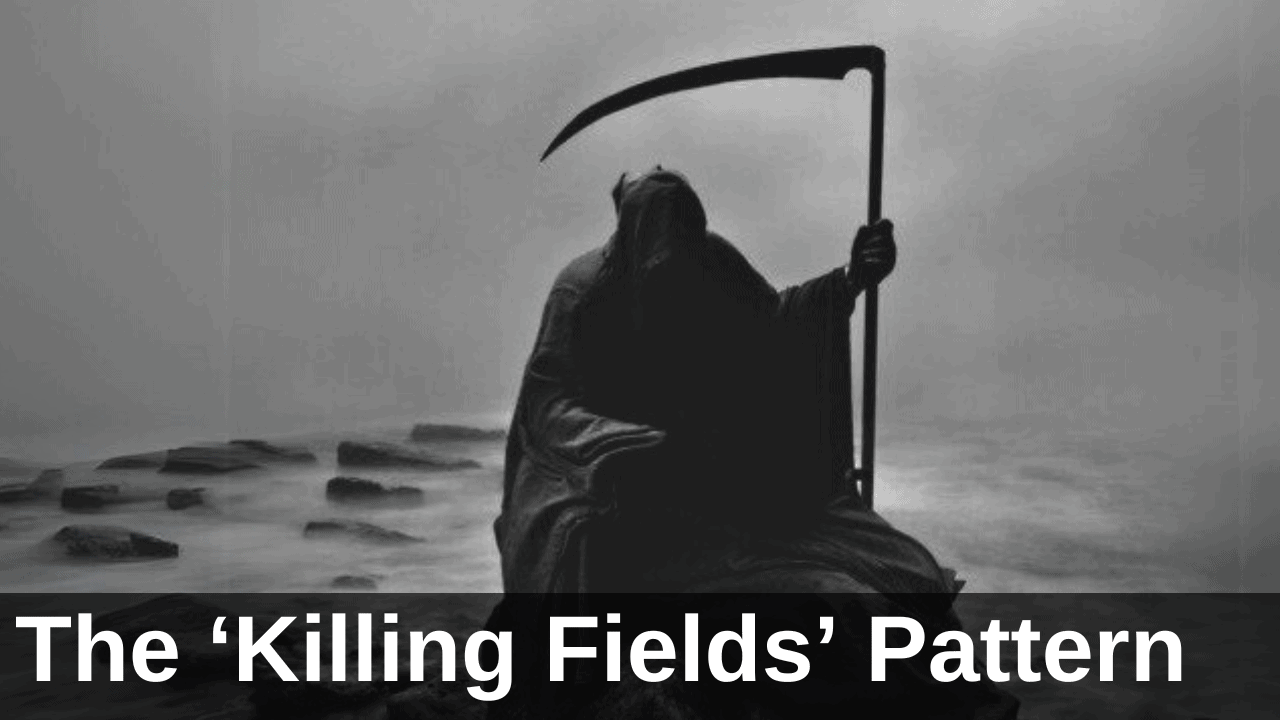As traders, watching charts day in and day out, we see the same chart patterns repeating, again and again. I like naming my patterns – silly names, like the RAMBO pattern and ‘The Gathering’ pattern. This article explains the ‘Killing Fields’ pattern, a setup designed to mislead traders.
Table of Contents
Use the links above to jump to the topic that interests you.
What Is the ‘Killing Fields’ Pattern?
The Killing Fields pattern emerges during market sell-offs. It is characterized by deceptive moves initiated by Professional traders – moves that trap retail or Amateur traders into making poor decisions. The key to identifying this pattern lies in understanding the behavior of Professionals and their role in creating false signals.
The example below is from Emini futures trading on Tuesday, January 7, 2025, using a 1,500-tick chart and the Better Pro Am indicator. Remember that:
- Professional activity is shown with blue bars, and
- Amateur activity is shown with yellow bars.
How the Pattern Develops

Step 1: No Professionals on Sell-Off
The Killing Fields pattern begins with an initial market sell-off, during which prices drop sharply and establish a new low. No blue Professional bars appear at this stage, signaling that the Professionals are not active yet. This marks the beginning of a trap.
Step 2: The Professional “Ramp”
After the sell-off, the Professionals engineer a short-covering rally, or “ramp.” They aggressively buy into this rally, triggering trailing stops and creating a temporary sense of market strength. As prices rise above recent pivot highs, inexperienced traders interpret this as a trend reversal and begin taking long positions.
Step 3: Wrong-Footing Amateurs
The strength in the ramp misleads Amateur traders into believing a bottom has formed. But after exhaustion buying, the market finds it difficult to go any higher, and the market slows. Any signs of strength can be seen to be led by Amateur yellow bars. However, Professionals are using this opportunity to build short positions, preparing for another leg down.
Step 4: Break to New Lows
Eventually, the Professionals have filled up on Short positions and are ready to let the market drop. As the market resumes its downtrend, Amateur traders find themselves caught on the wrong side of the trade. The selling accelerates, and the market moves quickly.
Step 5: Professionals Take Profits
The true bottom forms only after this significant drop. At the new lows, blue Professional bars start to appear. Often, you’ll see an exhaustion selling pattern. These blue bars indicate genuine accumulation by Professionals, signaling the end of the sell-off.
Recognizing the ‘Killing Fields’ in Real-Time
To identify the Killing Fields pattern as it unfolds, traders should look for these key signs:
- Lack of Professional Activity at Key Lows: The sell-off is not yet complete without blue Professional bars at the lows.
- Blue Professional Bars on the Rally: The presence of blue Professional bars during the rally, rather than at the lows, suggests that the rally is being engineered.
- Difficulty Making New Highs: The market slows, and any small rallies fizzle out. Patience is needed as the market approaches and tests the recent lows.
Using multiple timeframes, such as 500-tick and 1500-tick charts, can further confirm the chart pattern. For example, blue Professional bars on the higher timeframe chart can validate the activity seen on the lower timeframe chart.
Key Takeaways for Traders
If you recognize the signs of the Killing Fields pattern, you can avoid getting trapped by false signals and instead position yourself for a successful trade.
- Don’t Follow the Rally Blindly: Blue Professional bars during a rally often signal manipulation, not strength.
- Wait for True Bottoms: Only trust a bottom when blue Professional bars appear at new lows.
- Use Multiple Timeframes: Analyze both lower and higher timeframes to confirm the pattern.
The Killing Fields pattern is a powerful example of how Professional traders manipulate markets to their advantage. Practice identifying this pattern by reviewing your charts after every day’s trade – build confidence and improve your trading edge. Good luck with your trading!




